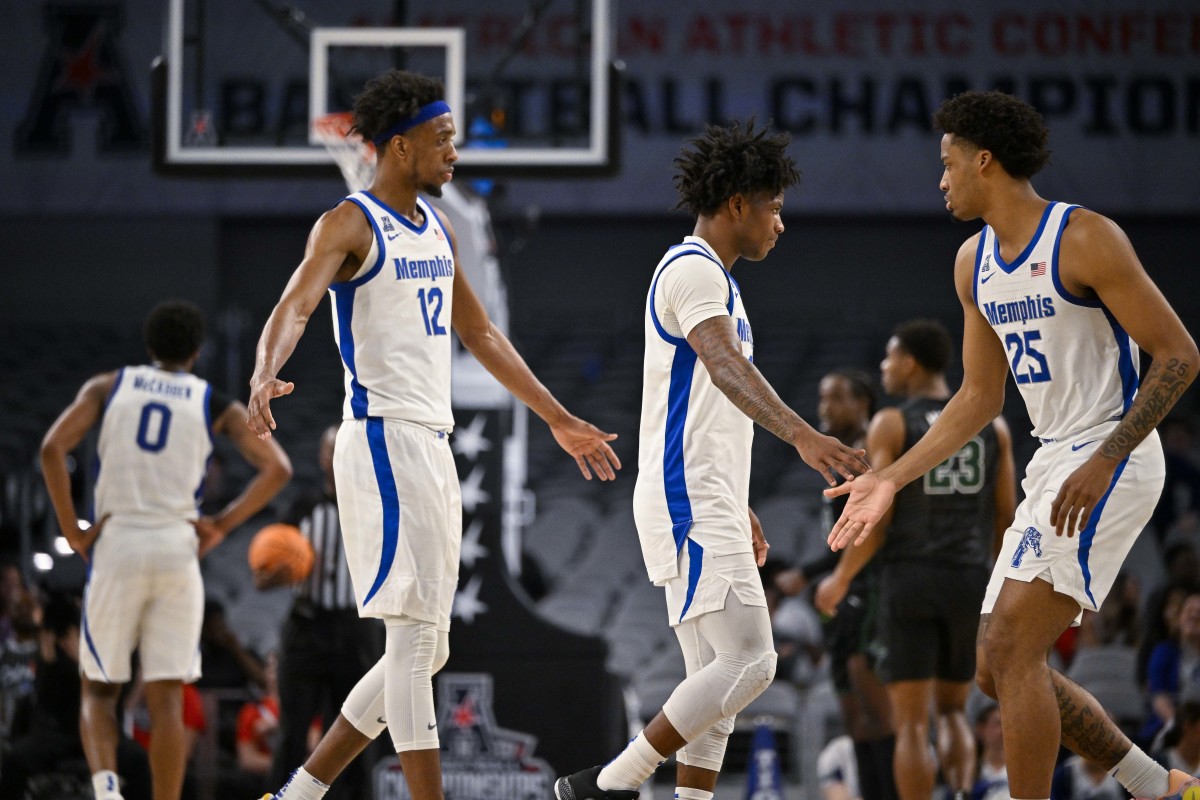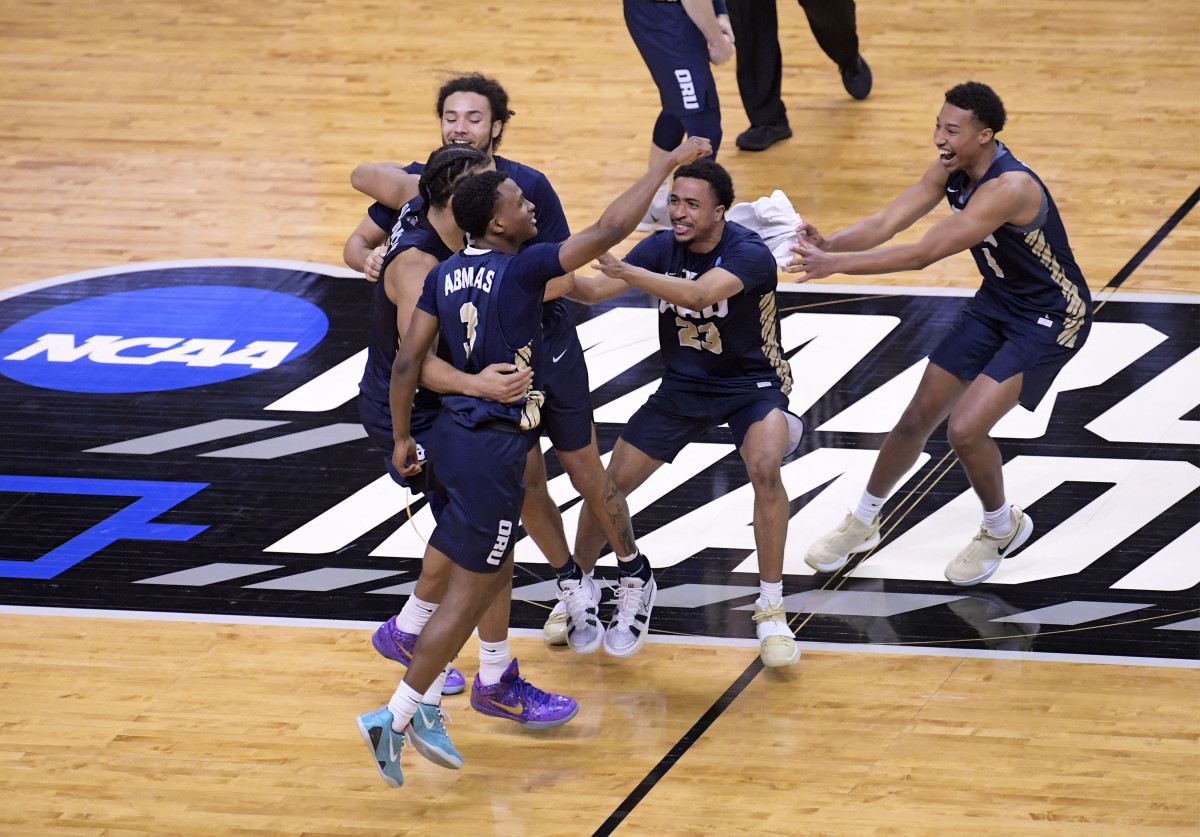The 10 Teams That Could Make Cinderella Runs in Men’s March Madness

Cinderella stories are one of the main reasons to love March Madness. Last year, we got to witness perhaps the sport’s greatest Cinderella ever, when No. 15 seed Saint Peter’s came out of nowhere to make a miracle run to the men’s Elite Eight. Less than 1% of brackets on the NCAA’s March Madness app had picked the Peacocks to reach the Elite Eight (a large percentage of those likely because of the school’s mascot).
Watch college basketball with fuboTV. Start your free trial today.
Who could be this year’s Saint Peter’s, the team that blows up everyone’s bracket and sends shock waves through the sport? Or North Carolina, the No. 8 seed that propelled its way straight to the national title game? Here’s a look at 10 of the most likely candidates:

Memphis
No. 8 seed, East Region
The Tigers left quite the final impression, blowing out Houston—albeit without Marcus Sasser—in the AAC title game. It was a reminder of why this team is so dangerous as a No. 8 seed: The Tigers are old and athletic at every spot, have one of the best point guards in the country in Kendric Davis and present a frontcourt matchup problem in DeAndre Williams. This is the type of team that can absolutely get to the second weekend of the NCAA tournament. And given that bluebloods UCLA and North Carolina have successfully made runs after underachieving regular seasons the last two years, Memphis fits the profile to do the same this March.
The Tigers get a brutal first-round matchup against FAU, another potential Cinderella that won 31 games this season. Whoever wins that game has a great chance to hang in against Purdue, which has looked like the most vulnerable No. 1 seed down the stretch this season. In the end, it’s hard to bet against a guard as good as Davis, who averages more than 22 points and five assists per game.
Furman
No. 13 seed, South Region
The Paladins are dancing for the first time in more than 40 years, and they have a chance to stick around awhile now that they’ve finally made the field. With one of the most efficient offenses in the country, one that shares the ball extremely well and is capable of lighting it up from three, Furman is a difficult matchup for No. 4 seed Virginia and has the experienced pieces necessary to pull an upset.
Guard Mike Bothwell will likely score his 2,000th career point in the opening-round matchup against the Cavaliers. He’s a hyperefficient shot-making guard who’s elite at getting to the rim and drawing fouls. The Paladins also have one of the most skilled big men in the country in Jalen Slawson, who averages more than three assists per game and makes 39% from three. That’s the type of duo that can win you a game or two in this tournament.
Plus, it’s hard not to like the Paladins’ draw. Virginia has struggled mightily lately and now is without starting center Ben Vander Plas due to a hand injury. And should Furman win that game, it’ll face a beatable San Diego State or Charleston team for a spot in the Sweet 16.
VCU
12 seed, West Region
VCU is the rare lower seed you could argue is more athletic than its first-round opponent. The Rams draw Saint Mary’s in the opening round in a game that figures to be low-scoring, given both teams rank in the top 20 nationally in defensive efficiency, per KenPom.
While the Rams’ only path to the Big Dance was winning the A-10 tournament, VCU has played like a very dangerous team in the last two months. They have two terrific guards in Ace Baldwin and Jayden Nunn, both of whom are high-impact defenders in addition to having scoring chops. This isn’t a great shooting team (outside of bench sharpshooter David Shriver), but it makes up for that by getting to the free throw line a ton and scoring easy baskets in transition. VCU’s greatest strength is its ability to force you to play its favored style of game, and drawing a freshman point guard in the first round before a potential date with a UConn team that has had point guard woes all season seems like a good match for a potential Cinderella run.
Drake
No. 12 seed, Midwest Region
With a starting lineup that is older than five NBA teams and features a pair of 25-year-olds in the backcourt, Drake’s mixture of experience and maturity alone gives them a chance in March. Add in the fact that the Bulldogs have an outstanding lead guard in Roman Penn, a high-level scorer (and matchup problem) in Tucker DeVries and a high-level coach in Darian DeVries, and it’s easy to see why Drake is a popular choice to bust brackets this year.
The Bulldogs played one high-major team this season (Mississippi State on a neutral court) and won 58–52. The year before, they led Alabama in the second half and took Clemson to overtime. This is a core of players that has been together three years, won 25 games or more in all three seasons and has proved its mettle in big games. Plus, the Bulldogs don’t beat themselves: They’re among the nation’s best at making free throws, taking care of the ball and keeping opponents off the offensive glass. Do those things, and you put players like Penn and Tucker DeVries in positions to win games late.
How well Drake matches up with Miami may well depend on the availability of Hurricanes center Norchad Omier, an essential piece for a team without much frontcourt depth. Without Omier, Miami seems incredibly beatable.
Oral Roberts
No. 12 seed, East Region
The Golden Eagles are no strangers to March success, having reached the Sweet 16 as a No. 15 seed in 2021. There are a lot of familiar faces remaining from that ’21 team, most notably star guard Max Abmas, who averaged more than 25 points per game in three NCAA tournament games two years ago.
The difference between this year’s ORU team and that 2021 squad is on the defensive end. The presence of 7'5" big man Connor Vanover, a transfer from Arkansas, has completely transformed this year’s group defensively. Buoyed by Vanover’s elite shot-blocking skills (he ranks fourth nationally in block rate), Oral Roberts now has a defense pushing the top 100 in KenPom’s efficiency metrics. Compare that to the No. 219 unit in ’21 and No. 290 in ’22, and it’s obvious why the Golden Eagles have improved so much from two seasons ago.

Combine that improved defense with an elite offense that emphasizes ball movement and three-point shooting, and you’ve got a team that can win more than one game in March. Abmas will be the best guard on the floor in most games he plays, and when the team’s role players are making threes (as they did in the Summit championship game against North Dakota State), Oral Roberts is tough to stop. It was dealt a rough hand by matching up with a hot Duke team in the first round, but the game is still winnable.
Kent State
No. 13 seed, Midwest Region
Buoyed by a top-50 defense nationally per KenPom and a talented veteran backcourt, the Golden Flashes have matched the program’s highest win total since the team went to the Elite Eight in 2002. There’s a lot to like here, particularly how battle-tested this team is: Kent State faced Houston and Gonzaga in nonconference play, both in true road games, and led both games in the final three minutes. That should give this group plenty of confidence that it can get over the finish line for an upset or two on a neutral court this week.
Point guard play is so critical in this setting, and Kent State has a high-level fifth-year floor general in Sincere Carry. With more than 1,900 career points and 600 assists to his name, few point guards in this event match Carry’s talent and experience.
But Kent State really wins games thanks to its turnover margin dominance. Against Houston, Kent State forced 23 turnovers, helping the Golden Flashes take 13 more shots than the Cougars. That’s a great recipe for success in March, and the Golden Flashes likely would have won the game had they not shot incredibly poorly from the field. Having an elite perimeter defender in Malique Jacobs to potentially neutralize Indiana star guard Jalen Hood-Schifino is huge, and if the Golden Flashes get past the Hoosiers, a deep run could be in store.
Watch March Madness games live with fuboTV. Start your free trial today!
Utah State
No. 10 seed, South Region
The Aggies are, in my opinion, built better for March than the other three Mountain West schools in the field. Quality metrics have Utah State in the top 20 nationally, and the Aggies are 33 spots higher on KenPom than first-round opponent Missouri.
The biggest reason this team is dangerous is its ability to shoot the three. The Aggies take a ton of threes and make them at a 38.5% clip, one of the top-15 marks nationally. The leader of that charge is point guard Steven Ashworth, who is one of just two players in the nation who has made more than 100 threes this season at at least a 43% clip. Guarding pick-and-pops with Ashworth and power forward Taylor Funk is a nightmare for opposing defenses, particularly given how good the spacing and off-ball movement is by the rest of the Aggies’ offense.
Matching up with another elite offense in Missouri in the first round should produce an incredibly entertaining game. And should the Aggies advance, they could be in for another shootout against Arizona.
Iona
No. 13 seed, West Region
Anytime you go into March with Rick Pitino as your coach, you should feel pretty good about your chances of winning the game. And while rumors swirl around Pitino’s future at Iona given the vacancy at St. John’s, the Gaels have a chance to make some noise in this tournament if they can block out that distraction.
The Gaels have found another gear in February and March after taking some lumps early in MAAC play, winning 14 straight after losing three of five late in January. The main reason for that turnaround has been getting star guard Walter Clayton Jr. back to full health. Clayton and Daniss Jenkins form one of the more dynamic mid-major backcourts in the country, with Clayton in particular a difficult matchup because of his elite shot-making ability and feel. Iona also won’t get beat up inside by a high-major thanks to Nelly Junior Joseph, who tallied 19 double doubles this season and is also an impressive shot blocker.
Pitino hasn’t pulled out his patented press as often this season because of injuries that have sapped his team’s depth, but in a single-elimination setting you’d expect him to pull out all the stops. Iona has the athletes to match bigger programs like UConn in the open floor, so that shouldn’t be an issue. The Gaels have to keep Junior Joseph out of foul trouble against Adama Sanogo and Donovan Clingan, but the Huskies’ frontcourt won’t overwhelm the Gaels.
Colgate
No. 15 seed, Midwest Region
The Raiders are representing the Patriot League in the Big Dance for the third time in a row. After leading in the second half of all three games (against Tennessee in 2019, Arkansas in ’21 and Wisconsin in ’22), is this the year Colgate will finally break through?
Perhaps no offense in the country is more aesthetically pleasing than the one coach Matt Langel runs at Colgate. The Raiders put on a clinic in ball and player movement every time they step on the floor, and they lead the country in both effective field goal percentage and three-point percentage. Colgate’s top two three-point shooters (seniors Oliver Lynch-Daniels and Ryan Moffatt) each shoot better than 45% from deep, with Lynch-Daniels knocking down a blistering 50% from distance this season.
The question for Colgate against high-major competition has always been how it matches up athletically. Arkansas eventually overwhelmed the Raiders with size and length two years ago, and the same could happen against the Longhorns. That said, a team that shoots the ball as well as Colgate does is always a threat to pull off an upset. And if the Raiders can win their first game, prepping for that offense on a short turnaround could be a major problem for a second-round opponent.
College of Charleston
No. 12 seed, South Region
Charleston spent much of February wondering whether it’d get an at-large bid, but instead removed all doubt by winning the CAA tournament and punching its ticket to the Big Dance that way. And while there’s no denying the schedule the Cougars played to get to 31 wins was somewhat soft, it still takes a special team to win as consistently as this group did even against subpar competition.
The strength of Charleston’s team is its depth. Nine players average between 15 and 30 minutes per game, and the Cougars have a wide variety of pieces that allow them to match up with teams that play almost any style of game. While they don’t shoot a blistering percentage from deep, Charleston ranks in the top 10 nationally in three-point rate. In particular, the backcourt trio of Ryan Larson, Reyne Smith and Dalton Bolon have each put up more than 175 threes this season and are capable of heating up in a single-elimination setting. They’ll need to make plenty of threes to crack the code against a San Diego State team that sports one of the nation’s best defenses.
